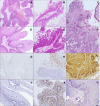Clinico-pathological Factors in Malignant Transformation of RRP
- PMID: 38440468
- PMCID: PMC10908916
- DOI: 10.1007/s12070-023-04220-3
Clinico-pathological Factors in Malignant Transformation of RRP
Abstract
Various clinico-pathological factors play role in the papilloma proliferation and pathogenesis of Recurrent respiratory papillomatosis (RRP). However, it is not known if they are directly responsible for malignant transformation of these papillomas or not. We did this study to elucidate any such association. The most recent debrided tissue of RRP in 20 patients was evaluated for p16 expression, VEGF estimation (tissue expression and serum levels), and tissue HPV DNA concentration. The final histopathology results were then correlated with these pathological factors and with clinical factors like duration of illness, age of onset of symptoms, extent of disease, etc. Squamous papilloma was seen in 60%, dysplasia in 25%, and squamous cell carcinoma (SCC) in 15% of the patients. Positive immunostaining for p16 (staining in ≥70% of tumor cells) was seen only in one case, which was SCC. There was no statistically significant difference between p16 expression, tissue VEGF expression, serum VEGF levels, and tissue HPV DNA in any of the histological groups. The mean age of disease onset was significantly higher in patients with SCC (p = 0.03). A significantly higher number of patients with dysplasia had tracheobronchial involvement (p = 0.022). We concluded that no single pathological factor is solely responsible for development of malignancy in RRP, whereas clinical factors like tracheobronchial involvement and age of onset may contribute to development of dysplasia or carcinoma.
Keywords: HPV DNA; Recurrent respiratory papillomatosis; VEGF; p16.
© Association of Otolaryngologists of India 2023. Springer Nature or its licensor (e.g. a society or other partner) holds exclusive rights to this article under a publishing agreement with the author(s) or other rightsholder(s); author self-archiving of the accepted manuscript version of this article is solely governed by the terms of such publishing agreement and applicable law.
Conflict of interest statement
Conflict of interestThe authors declare no conflict of interests.
Figures



References
-
- Wiatrak BJ, Wiatrak DW, Broker TR, Lewis L. Recurrent respiratory papillomatosis: a longitudinal study comparing severity associated with human papilloma viral types 6 and 11 and other risk factors in a large pediatric population. Laryngoscope. 2004;114(11 Pt 2 Suppl 104):1–23. doi: 10.1097/01.MLG.000148224.83491.0F. - DOI - PubMed
LinkOut - more resources
Full Text Sources
Research Materials
